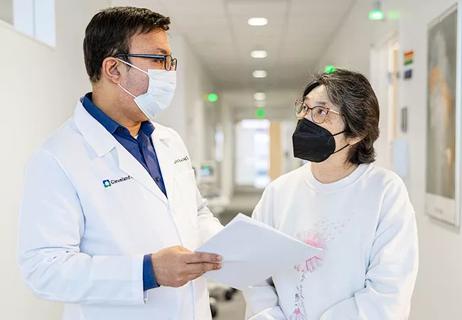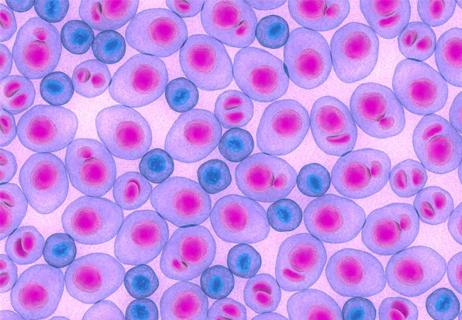Despite sicker patients, response rates of teclistamab in a real-world study were similar to those from a pivotal clinical trial

A real-world study confirms the efficacy of teclistamab in patients with heavily pretreated relapsed/refractory multiple myeloma (RRMM), including those with high-risk features of the disease.
Advertisement
Cleveland Clinic is a non-profit academic medical center. Advertising on our site helps support our mission. We do not endorse non-Cleveland Clinic products or services. Policy
“The real-world experience demonstrates response rates comparable to those observed in the pivotal phase 2 MajesTEC-1 trial despite the inclusion of sicker patients who would not have been eligible for MajesTEC-1,” says Danai Dima, MD a hematology-oncology fellow at Cleveland Clinic, who is the principal investigator of the study. “Our study gives us much more information about how real-world patients will respond to teclistamab,” she says.
“This multi-institute, retrospective trial on the use of BCMA-targeting T-cell engager teclistamab gives us a unique opportunity to learn about its efficacy and safety for the heavily-treated patient population,” says Faiz Anwer, MD, FACP, Director of Inpatient Lymphoma Myeloma Service. “Despite not being able to meet the MajesTEC-1 eligibility criteria in more than 80% of cases as well as prior exposure to BCMA-directed therapy, a significant number of patients still showed benefit from the use of teclistamab.”
On the basis of the positive results from the MajesTEC-1 trial, teclistamab, a B-cell maturation antigen (BCMA) targeting bispecific T-cell engager, was approved by the U.S. Food and Drug Administration in October 2022 for the treatment of patients with RRMM who have received at least four prior lines of therapy. Like many other landmark registration trials evaluating novel agents, the MajesTEC-1 implemented stringent eligibility criteria. Patients enrolled were likely not reflective of the broader real-world patients, who typically present with significant comorbidities, organ dysfunction, severe cytopenias, prior exposure to anti-BCMA therapy and high-risk disease features.
Advertisement
“Consequently, it is crucial to investigate the real-world utilization patterns of teclistamab and evaluate outcomes in high-risk patients who would have been considered ineligible to receive teclistamab in a clinical trial,” says Dr Dima.
To evaluate real-world performance, the researchers examined outcomes from 106 patients with RRMM who were treated with teclistamab at five different U.S. academic centers. This included 88 (83%) patients who would not have met eligibility criteria for the MajesTEC-1 trial. Notably, 37 patients in the real-world study received treatment at Cleveland Clinic.
Approximately half (53%) of the patients in the real-world cohort had received prior BCMA-directed therapies, whereas prior BCMA-directed therapy was an exclusion criterion of MajesTEC-1.
High-risk features were prevalent in the real-world study. In detail, 64% of patients had penta-class refractory disease, 59% of patients had high-risk cytogenetics, 42% had extramedullary disease and 33% had poor performance status (defined as an Eastern Cooperative Oncology Group (ECOG) performance status ≥2, and 13% had renal dysfunction defined as creatinine clearance <40 mL/min and 32% were >70 years old). “Our population was much sicker than the trial patients” Dr. Dima emphasizes.
Despite the real-world population with high-risk features, the overall response rate (ORR) in the real-world study was encouraging at 66%, compared with 63% in the MajesTEC-1 trial. The ORR in the real-world study were 63% in patients with high-risk cytogenetics, 71% in patients with penta-refractory disease, 68% in patients >70 years old and 52% in patients with stage-3 disease.
Advertisement
The median duration of response with weekly teclistamab in the MajesTEC-1 trial was 18.4 months with a median follow-up of 14.1 months. “The median time to best response in MajesTEC-1 was 3.8 months, and the median follow-up in our study was 3.8 months, so I think that with longer follow-up, we may see deepening of responses,” Dr. Dima says.
The complete response rate was higher in the MajesTEC-1 trial at 39%, compared with 29% in the real-world population, and the rate of disease progression without achieving a response was also worse in the retrospective real-world cohort (24.5%) compared with the MajesTEC-1 trial (14.5%). “This is expected based on how sick our patients were,” she says.
On multivariate analysis, the factors that were independently associated with inferior overall response included the presence of extramedullary disease, ECOG performance status ≥2 and receipt of more than four prior lines of therapy.
The ORR in patients who received prior BCMA-directed therapy was similar to that in the overall study population. The most common prior BCMA-directed therapy was commercial CAR T-cell therapy. Dr. Dima expressed optimism, stating that “it is encouraging that we can give teclistamab successfully after failure of CAR T-cell cell therapy.”
Determining the safety of teclistamab in a severely ill myeloma patient population is of paramount importance. The frequency and severity of adverse events were similar to those in the MajesTEC-1 trial. “We did not see any new red flags or excessive toxicities,” she said.
Advertisement
The main side effects that arise with bispecific antibodies, including teclistamab, are cytokine release syndrome (CRS) and immune effector cell-associated neurotoxicity syndrome (ICANS). The rates of both were similar to those in the MajesTEC-1 trial. Among other complications, more than 60% of patients experienced CRS and more than a quarter of patients had infectious complications. Dr. Dima highlights that the low incidence of severe CRS and ICANS in her study raises the possibility of safely administering teclistamab on an outpatient basis without necessitating hospitalization, provided that appropriate measures, resources and infrastructure are in place. The safety data also suggest the potential for teclistamab administration in community centers by local oncologists, especially after the initial step-up dosing.
A higher rate of infection was observed in the MajesTEC-1 trial, but median follow-up was longer compared with the real-world study (14.1 vs. 3.8 months). “You would expect a higher rate of infection with longer follow-up if patients stay on therapy,” Dr. Dima says. There were three deaths from infectious complications in each study.
“It is important to educate and enable members of treatment teams to promptly recognize and treat side effects and if possible, use strategies to prevent complications,” says Dr. Answer.
Advertisement
Advertisement

Phase 2 study brings pivotal advances in treatment efficacy and safety for the most challenging-to-treat population

Making sense of the fast-moving treatment landscape

Explaining common misconceptions about chimeric antigen receptor therapy

Clinicians share practices to streamline initiation of care

Prediction and bioinformatic data could prove valuable for therapeutic interventions targeting this malignancy

Findings from large database important to inform clinical practice

Study of 401,576 patients reveals differences in cancer burdens as well as overall survival

Strategies and risk models are evolving for this asymptomatic condition